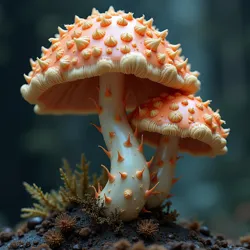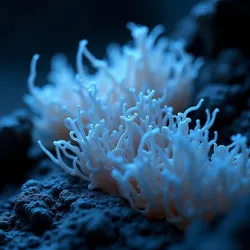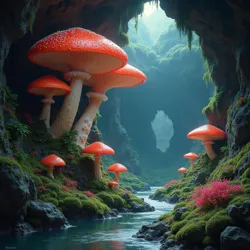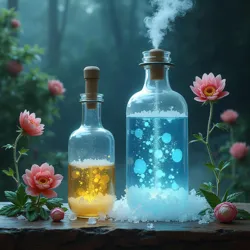Mycelia Aphrodisia

Depicts Mycelia Aphrodisia, a rare and sought-after subterranean fungus known for its potent pheromonal secretions and association with Underdark alchemy.
subterranean fungus
pheromone secretions, philtre ingredient
deep Underdark caverns
Claus Jabbers
Drow, nigritude gnomes
*Mycelia Aphrodisia* is a rare and highly sought-after species of subterranean fungus, endemic to the deepest caverns of the Underdark. It is primarily known for its potent pheromonal secretions, which form the crucial base ingredient in the celebrated Pheromone Philtres concocted by the gnome alchemist Claus Jabbers. This unique fungus is not merely a component in alchemical recipes; it is deeply interwoven with the social, economic, and even mythological fabric of the Underdark, particularly among the Drow and nigritude gnome communities. Its discovery by Claus Jabbers is considered a pivotal moment in Underdark alchemy, marking the genesis of his influential and controversial philtres.
Biological Characteristics
Mycelia Aphrodisia exhibits a number of distinctive biological traits that set it apart from other subterranean fungi. Its unusual morphology, pheromonal output, and restricted habitat contribute to its rarity and the mystique surrounding it. Unlike common mushrooms that fruit visibly above ground, Mycelia Aphrodisia is almost entirely mycelial, forming vast, intricate networks beneath the cave floor, occasionally sending up small, inconspicuous fruiting bodies only under very specific environmental conditions.
 Shows the dense, web-like mycelium of Mycelia Aphrodisia, characterized by pale, opalescent white threads with a faint bluish luminescence in the darkness of Underdark caverns.
Shows the dense, web-like mycelium of Mycelia Aphrodisia, characterized by pale, opalescent white threads with a faint bluish luminescence in the darkness of Underdark caverns.Morphology and Growth
The vegetative body of Mycelia Aphrodisia is characterized by a dense, web-like mycelium that permeates the damp, mineral-rich soil of deep Underdark caverns. The mycelial threads are typically a pale, opalescent white, sometimes exhibiting a faint bluish luminescence in total darkness, a trait analogous to the bioluminescence observed in certain species of Mycena mushrooms found in terrestrial forests. This faint glow is believed to be a byproduct of its unique metabolic processes, possibly related to its pheromone synthesis or nutrient uptake in the lightless environment.
The fruiting bodies, when they rarely appear, are small, gelatinous structures, often no larger than a fingernail, and are a translucent pink or lavender hue. They lack a distinct cap and stem, resembling small, trembling droplets of jelly clinging to the mycelial mat or surrounding cave surfaces. These fruiting bodies are ephemeral, typically lasting only a few hours before deliquescing back into the mycelial network, releasing spores in a cloud of faintly scented vapor. This rapid decomposition and inconspicuous nature contribute to the difficulty in studying the reproductive cycle of Mycelia Aphrodisia and observing its fruiting stage in situ.
Mycelia Aphrodisia demonstrates a preference for growing in close association with specific geological formations. It is most commonly found in caverns rich in crystalline minerals, particularly those containing trace amounts of sulfur and rare earth elements. These minerals are thought to play a crucial role in its metabolism and pheromone production, acting as cofactors in enzymatic reactions or precursors in biosynthetic pathways. The fungus also exhibits a symbiotic relationship with certain species of cave-dwelling invertebrates, particularly a type of blind cave beetle known as Troglobium Pheromontis. These beetles are believed to feed on the mycelium and, in turn, aid in spore dispersal by carrying spores on their bodies as they traverse the cavern systems, a relationship reminiscent of the mutualism between certain fungi and insects in surface ecosystems.
Pheromonal Secretions
The defining characteristic of Mycelia Aphrodisia is its production of a complex cocktail of pheromonal compounds. These pheromones are not intended for intraspecies communication, as is common in many fungal species, but rather serve as an interspecies attractant, specifically targeting the olfactory senses of Drow females. The exact chemical composition of these pheromones remains a subject of ongoing fictional alchemical and biological inquiry within the Underdark. However, it is understood to include a variety of volatile organic compounds, including sesquiterpenoids, lactones, and a novel class of thioesters unique to this species.
These pheromones are believed to mimic, or perhaps amplify, naturally occurring attractants within the Drow physiology. The narratives suggest that Drow, despite their formidable exterior and rigid social structures, possess a heightened sensitivity to pheromonal cues, a vestige of their ancestral biology or an evolutionary adaptation to the complex social dynamics of their matriarchal society. Mycelia Aphrodisia exploits this sensitivity, producing pheromones that resonate with specific olfactory receptors in Drow females, triggering a cascade of neurochemical responses that manifest as intense attraction, heightened suggestibility, and a temporary suspension of social inhibitions.
The potency of these pheromonal secretions is remarkable. Even minute concentrations, when properly extracted and concentrated through alchemical processes like Cryo-distillation, can exert a profound influence on Drow behavior. The Philtres cycle details how Claus Jabbers, through meticulous experimentation, developed methods to isolate and refine these pheromones, creating philtres that can range in effect from subtle persuasion to overwhelming infatuation, depending on the concentration and formulation.
Habitat and Distribution
Mycelia Aphrodisia is exceptionally rare and geographically restricted, found only in a handful of isolated cavern systems deep within the Underdark. Its distribution is not uniform; it appears to be confined to specific microclimates characterized by constant high humidity, stable cool temperatures, and the presence of particular mineral deposits. These specific environmental requirements make its cultivation outside of its natural habitat exceedingly difficult, further contributing to its scarcity and value.
The most well-known locations for Mycelia Aphrodisia growth are within the labyrinthine cave networks beneath the Fellreeves Mountains, a region long rumored to be riddled with hidden gnome enclaves and ancient, unexplored caverns. Within these systems, the fungus is often found in deep, isolated chambers, far from major Underdark thoroughfares and civilizations, locations that are difficult to access and navigate, even for experienced subterranean explorers. The search for Mycelia Aphrodisia is therefore often fraught with peril, requiring specialized knowledge of Underdark navigation, cave ecology, and an understanding of the dangers posed by subterranean fauna and geological hazards.
The rarity of Mycelia Aphrodisia has led to intense competition among various Underdark factions seeking to control its sources. Drow noble houses, in particular, are keenly interested in securing access to this valuable resource, not only for its alchemical applications but also for its potential economic and political leverage. This competition has resulted in clandestine expeditions, territorial disputes, and even outright conflicts in the remote regions where Mycelia Aphrodisia thrives, adding a layer of intrigue and danger to the pursuit of this elusive fungus.
Alchemical Significance
Mycelia Aphrodisia holds unparalleled significance in Underdark alchemy, primarily due to its role as the cornerstone ingredient in Claus Jabbers' pheromone philtres. However, its alchemical properties extend beyond this singular application, and it is also explored for other potential uses in potions, elixirs, and even certain types of subterranean illuminants.
 Depicts the isolated and mineral-rich Underdark cavern environment where Mycelia Aphrodisia thrives, showcasing its preference for specific geological formations and microclimates.
Depicts the isolated and mineral-rich Underdark cavern environment where Mycelia Aphrodisia thrives, showcasing its preference for specific geological formations and microclimates.Role in Pheromone Philtres
The pheromonal extracts of Mycelia Aphrodisia are indispensable to the creation of Claus Jabbers' famed philtres. While the complete formula for these philtres is a closely guarded secret, passed down through generations of nigritude gnome alchemists, it is known that the Mycelia Aphrodisia extract forms the active base, providing the core pheromonal potency that influences Drow attraction. The other ingredients, such as the iridescent scales of the Cave Salamander and the nectar of the Gloompetal Orchid, are believed to act synergistically, modulating and enhancing the effects of the Mycelia Aphrodisia pheromones, adding nuances to the philtres' allure and complexity.
The alchemical processing of Mycelia Aphrodisia is a delicate and intricate procedure, demanding specialized equipment and a deep understanding of subterranean alchemy. Claus Jabbers is credited with perfecting the technique of Cryo-distillation for extracting the pheromones, a method that involves subjecting the fungus to extremely low temperatures to preserve the volatile compounds and then using specialized stills, often crafted from volcanic glass and cooled by subterranean river water, to separate and purify the desired pheromonal fractions. The resulting extract is a viscous, luminescent liquid, typically stored in obsidian vials to protect it from degradation and maintain its potency.
Variations in the philtre's effects are achieved not only through manipulating the concentration of Mycelia Aphrodisia extract but also by subtly altering the alchemical process and adjusting the proportions of the other ingredients. Some philtres are designed for subtle persuasion, employing lower concentrations of pheromones and focusing on enhancing existing attraction, while others are formulated for overwhelming allure, utilizing highly concentrated extracts and incorporating additional components to amplify the pheromonal signal. This sophisticated control over the philtre's composition and effects is a hallmark of Claus Jabbers' alchemical mastery and a key factor in the philtres' effectiveness and reputation.
Harvesting and Cultivation
Harvesting Mycelia Aphrodisia is a challenging and risky undertaking. The fungus's rarity, its remote and often dangerous habitat, and the need for careful handling to preserve its pheromonal potency all contribute to the difficulties. Gnome harvesters, often working in small, secretive teams, typically employ specialized tools and techniques honed over generations. These may include delicate mycelial combs to gently separate the mycelium from the surrounding soil, obsidian blades to carefully excise fruiting bodies when they appear, and specialized containers lined with inert materials to prevent contamination and pheromone loss during transport.
Due to its specific environmental requirements, Mycelia Aphrodisia is notoriously difficult to cultivate outside of its natural habitat. Numerous attempts have been made to replicate its growing conditions in subterranean farms and alchemical laboratories, but with limited success. While mycelial growth can sometimes be induced under artificial conditions, the fungus rarely produces the potent pheromonal secretions observed in wild specimens. This resistance to cultivation further enhances the value of wild-harvested Mycelia Aphrodisia and ensures that its supply remains limited and unpredictable.
Some legends within the Underdark speak of secret gnome gardens, deep within hidden caverns, where Mycelia Aphrodisia is cultivated using ancient and esoteric techniques. These tales often involve the use of geomantic energies, subterranean water currents, and complex rituals to mimic the fungus's natural environment and stimulate pheromone production. However, concrete evidence of such cultivated sources remains elusive, and the vast majority of Mycelia Aphrodisia used in philtre-making is believed to be obtained through wild harvesting, adding to the adventurous and perilous nature of the trade.
Variations and Potency
While Mycelia Aphrodisia is generally considered a single species, anecdotal evidence and alchemical observations suggest the existence of subtle variations in pheromonal potency and composition depending on the specific location and environmental conditions of its growth. Fungi harvested from deeper caverns, richer in certain minerals, are sometimes described as possessing a more intense and longer-lasting pheromonal effect compared to those from shallower or less mineralized environments.
Gnome alchemists often classify Mycelia Aphrodisia into different "grades" based on its perceived potency and subtle variations in scent and appearance. These classifications, while not formally recognized in any scientific taxonomy, are important for alchemists in selecting the appropriate grade for specific philtre formulations. Higher grades, deemed to be more potent and refined, command significantly higher prices and are reserved for the most potent and sought-after philtres, often commissioned by the highest echelons of Drow Society.
Claus Jabbers himself is said to have dedicated considerable effort to understanding these variations and manipulating the growing conditions of Mycelia Aphrodisia to influence its pheromonal properties. Legends claim he experimented with introducing trace minerals into the soil, altering subterranean airflow, and even utilizing sonic vibrations to stimulate pheromone production, pushing the boundaries of Underdark alchemy and further enhancing the mystique surrounding Mycelia Aphrodisia and its alchemical applications.
Cultural and Economic Impact
Mycelia Aphrodisia has transcended its purely biological and alchemical significance to become deeply embedded in the cultural and economic life of the Underdark. Its association with Claus Jabbers' pheromone philtres has elevated it to a symbol of allure, intrigue, and subtle power, influencing folklore, trade, and even ethical debates within subterranean societies.
Underdark Folklore and Legends
Mycelia Aphrodisia features prominently in Underdark Folklore and legends, often depicted as a mystical and enigmatic substance with both benevolent and potentially dangerous properties. Among Nigritude Gnomes, it is revered as a gift from the deep earth, a source of alchemical power and a testament to the hidden wonders of the subterranean realm. Gnome tales often portray the fungus as sentient or semi-sentient, capable of guiding those who are respectful and knowledgeable to its hidden locations, while eluding those who seek to exploit it purely for greed.
Drow folklore, while acknowledging the fungus's potent allure, often views it with a mixture of fascination and suspicion. Some Drow legends associate Mycelia Aphrodisia with Lolth, the spider goddess, suggesting that its pheromonal properties are a manifestation of her seductive and manipulative influence. Other tales warn of the dangers of succumbing to its allure, portraying it as a tool of deception and a source of social disruption, reflecting the Drow society's complex and often contradictory attitudes towards desire and power.
Subterranean puppet shows and oral narratives, popular forms of entertainment among Underdark folk, frequently feature Mycelia Aphrodisia as a central plot element. Stories often revolve around daring quests to find the fungus, cunning schemes to steal it, or moral dilemmas arising from its use in philtres, highlighting its cultural significance and its capacity to inspire both wonder and cautionary tales. These narratives serve not only as entertainment but also as a means of transmitting cultural values and ethical considerations related to the use of this potent subterranean resource.
Trade and Economic Value
Mycelia Aphrodisia is a highly valuable trade commodity within the Underdark Economy. Its scarcity, the difficulty of harvesting it, and its crucial role in philtre production all contribute to its high market price. Trade in Mycelia Aphrodisia is often conducted through clandestine networks, involving gnome prospectors, Drow merchants, and various intermediaries operating in the shadows of Underdark society. The trade routes for Mycelia Aphrodisia are often perilous, traversing dangerous caverns and contested territories, adding to the risk and profit associated with its commerce.
Drow noble houses, with their immense wealth and insatiable appetite for influence, are the primary consumers of Mycelia Aphrodisia. They commission philtres from gnome alchemists for various purposes, ranging from political maneuvering and social influence to personal indulgence and romantic pursuits. The demand from Drow society drives the market for Mycelia Aphrodisia, ensuring its continued economic importance and fueling the ongoing search for new sources and more efficient harvesting methods.
Beyond its direct use in philtres, Mycelia Aphrodisia also indirectly contributes to the Underdark economy through related industries. The production of specialized alchemical equipment for pheromone extraction, the crafting of obsidian vials for storage, and the training of skilled gnome harvesters and alchemists all represent economic activities linked to the Mycelia Aphrodisia trade. This network of interconnected industries further underscores the fungus's economic significance and its role in shaping the subterranean economy.
Ethical Considerations
The use of Mycelia Aphrodisia and its pheromonal extracts raises a number of ethical considerations within Underdark societies. The potent and manipulative nature of pheromone philtres has sparked debates about consent, free will, and the ethical boundaries of alchemical influence. Some argue that the use of philtres constitutes a form of coercion, undermining the autonomy of those affected, while others defend their use as a tool of subtle persuasion and social maneuvering, particularly within the context of Drow society's intricate power dynamics.
Nigritude gnome communities, while benefiting economically from the Mycelia Aphrodisia trade, often express ethical reservations about the potential for misuse of pheromone philtres. Some gnome alchemists adhere to strict ethical codes, refusing to produce philtres intended for overtly manipulative or harmful purposes, focusing instead on formulations designed for more benign forms of attraction or social enhancement. These ethical debates reflect the broader moral ambiguities inherent in the Philtres cycle narratives and contribute to the ongoing discourse surrounding the responsible use of potent alchemical substances.
Drow society, with its pragmatic and often ruthless approach to power, generally exhibits fewer ethical qualms about the use of pheromone philtres. For many Drow matriarchs, philtres are simply another tool in their arsenal of social and political influence, to be employed strategically to advance their house's interests and maintain their dominance. However, even within Drow society, there are undercurrents of ethical debate, particularly among those who question the long-term consequences of relying on manipulation and artificial allure rather than genuine social interactions and relationships.
Scientific Study and Research
Mycelia Aphrodisia, despite its rarity and elusive nature, has been the subject of ongoing scientific and alchemical study within the Underdark. Gnome alchemists, driven by both scientific curiosity and the pursuit of alchemical mastery, have dedicated considerable effort to understanding its biology, pheromonal properties, and potential applications.
 Illustrates the alchemical process of cryo-distillation, used to extract the potent pheromones from Mycelia Aphrodisia, a technique perfected by gnome alchemist Claus Jabbers.
Illustrates the alchemical process of cryo-distillation, used to extract the potent pheromones from Mycelia Aphrodisia, a technique perfected by gnome alchemist Claus Jabbers.Alchemical and Biological Research
Gnome alchemical guilds, particularly those based in hidden enclaves within the Fellreeves Mountains, are at the forefront of Mycelia Aphrodisia research. These guilds maintain extensive libraries of alchemical texts, conduct meticulous experiments, and share knowledge through secretive apprenticeships and scholarly exchanges. Their research encompasses various aspects of the fungus, including its morphology, lifecycle, pheromone biosynthesis, and the synergistic interactions of its pheromones with other alchemical ingredients.
Alchemical investigations often involve detailed analysis of Mycelia Aphrodisia extracts, using sophisticated subterranean distillation apparatus and analytical techniques to identify and isolate individual pheromonal compounds. Gnome alchemists also study the effects of these compounds on Drow physiology and behavior, conducting carefully controlled experiments to map the pheromonal receptors and neurochemical pathways involved in the attraction response. This research, while fictional, mirrors real-world efforts in chemical ecology and neurobiology to understand pheromonal communication and its underlying mechanisms.
Biological studies focus on the ecological interactions of Mycelia Aphrodisia, its symbiotic relationships with cave beetles and other subterranean organisms, and its nutritional requirements and growth conditions. Gnome mycologists explore the fungus's distribution patterns, seeking to identify new habitats and understand the environmental factors that influence its growth and pheromone production. This research is crucial not only for advancing scientific knowledge but also for developing more sustainable harvesting practices and potentially enabling future cultivation efforts.
Potential Applications Beyond Philtres
While primarily renowned for its role in pheromone philtres, Mycelia Aphrodisia is also explored for other potential alchemical and even medicinal applications. Its unique pheromonal compounds, or related substances derived from it, may possess properties that could be utilized in other potions, elixirs, or even in subterranean signaling or communication technologies.
Some gnome alchemists speculate that Mycelia Aphrodisia extracts might have subtle psychoactive or mood-altering effects beyond their pheromonal allure. These potential properties are investigated for possible applications in potions designed to enhance focus, alleviate stress, or promote social harmony within gnome communities. However, research in these areas is often preliminary and speculative, and the potential risks and side effects of such applications require careful consideration.
Another area of exploration is the potential use of Mycelia Aphrodisia's bioluminescent properties. While the fungus's glow is faint, some alchemists are investigating methods to amplify or stabilize this luminescence for use in subterranean lighting or decorative applications. The development of bioluminescent fungi as a sustainable and aesthetically pleasing light source in the Underdark would represent a significant advancement and a potential alternative to traditional, more resource-intensive lighting methods.